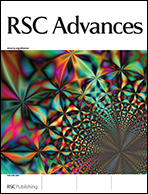Structural characterization of cationic liposome/poly(I:C) complexes showing high ability in eliminating prostate cancer cells†
Abstract
Polyriboinosinic acid–polyribocytidylic acid (poly(I:C)) is a mimic of viral double-strand (ds)RNA that induces apoptosis in many cancer cells. However, toxicity and stability issues so far prevented its application as it undergoes enzymatic degradation and bear the potential to trigger undue immune stimulation as well as autoimmune disorders. Encapsulation of antitumor drugs is frequently used to improve their effectiveness by lowering the necessary dosage. In this study we examined the ability of cationic liposomes to deliver poly(I:C) into PC3 and DU145 cell lines, derived from human bone and brain prostate cancer metastasis, respectively. The first formulation was made of the cationic lipid 1,2-dioleoyl-3-trimethylammonium-propane (DOTAP) and the zwitterionic lipid dioleoylphosphocholine (DOPC). The second one was the binary lipid system made of the cationic 3β-[N-(N′,N′-dimethylaminoethane)-carbamoyl]-cholesterol (DC-Chol) and the zwitterionic helper lipid dioleoylphosphatidylethanolamine (DOPE), while the third formulation was the multicomponent (MC) lipid system encapsulating the four lipid species simultaneously. Synchrotron small angle X-ray scattering revealed that cationic liposome/poly(I:C) complexes exhibit lamellar phases structurally similar to cationic liposome/DNA complexes. We further found that cationic liposomes/poly(I:C) complexes were up to 10 times more efficient in eliminating metastatic prostate cancer cells than the free drug. Finally, the ability of distinct lipid formulations to induce apoptosis could inversely correlate with their endosomal escape ability. This property of cationic liposome/poly(I:C) complexes contrasts to cationic liposome/DNA complexes, where the endosomal escape ability is the rate-limiting step for the transfection efficiency.


 Please wait while we load your content...
Please wait while we load your content...